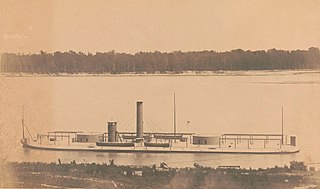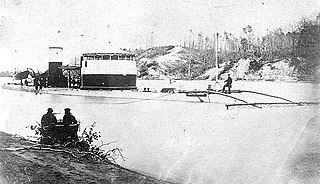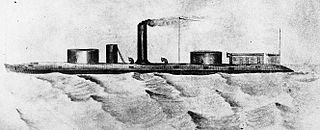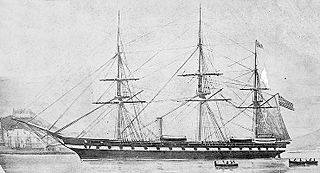
An ironclad is a steam-propelled warship protected by iron or steel armor plates, constructed from 1859 to the early 1890s. The ironclad was developed as a result of the vulnerability of wooden warships to explosive or incendiary shells. The first ironclad battleship, Gloire, was launched by the French Navy in November 1859 - narrowly pre-empting the British Royal Navy.

USS Galena was a wooden-hulled broadside ironclad built for the United States Navy during the American Civil War. The ship was initially assigned to the North Atlantic Blockading Squadron and supported Union forces during the Peninsula Campaign in 1862. She was damaged during the Battle of Drewry's Bluff because her armor was too thin to prevent Confederate shots from penetrating. Widely regarded as a failure, Galena was reconstructed without most of her armor in 1863 and transferred to the West Gulf Blockading Squadron in 1864. The ship participated in the Battle of Mobile Bay and the subsequent Siege of Fort Morgan in August. She was briefly transferred to the East Gulf Blockading Squadron in September before she was sent to Philadelphia, Pennsylvania for repairs in November.

USS Onondaga was an ironclad river monitor built for the Union Navy during the American Civil War. Commissioned in 1864, the ship spent her entire active career with the James River Flotilla covering the water approaches to the Confederate States capital of Richmond, Virginia, although her only notable engagement was the Battle of Trent's Reach. After the war, she was purchased by France where she served as a coastal defense ship in the French Navy.

Kōtetsu, later renamed Azuma, was the first ironclad warship of the Imperial Japanese Navy. She was designed as an armored ram for service in shallow waters, but also carried three guns. The ship was built in Bordeaux, France, for the Confederate States Navy under the cover name Sphinx, but was sold to Denmark after sales of warships by French builders to the Confederacy was forbidden in 1863. The Danes refused to accept the ship and sold her to the Confederates which commissioned her as CSS Stonewall in 1865. The ship did not reach Confederate waters before the end of the American Civil War in April and was turned over to the United States.

USS Canonicus was a single-turret monitor built for the United States Navy during the American Civil War, the lead ship of her class. The ship spent most of her first year in service stationed up the James River, where she could support operations against Richmond and defend against a sortie by the Confederate ironclads of the James River Squadron. She engaged Confederate artillery batteries during the year and later participated in both attacks on Fort Fisher, defending the approaches to Wilmington, North Carolina, from December 1864 to January 1865.

USS Chickasaw was an ironclad Milwaukee-class river monitor built for the United States Navy during the American Civil War. The ship participated in the Battle of Mobile Bay in August 1864, during which she was lightly damaged, and the bombardments of Forts Gaines and Morgan as Union troops besieged the fortifications defending the bay. In March–April 1865, Chickasaw again supported Union forces during the Mobile Campaign as they attacked Confederate fortifications defending the city of Mobile, Alabama.

USS Tecumseh was a Canonicus-class monitor built for the United States Navy during the American Civil War. Although intended for forthcoming operations against Confederate fortifications guarding Mobile Bay with Rear Admiral David Farragut's West Gulf Blockading Squadron, Tecumseh was temporarily assigned to the James River Flotilla in April 1864. The ship helped to plant obstacles in the river and engaged Confederate artillery batteries in June.

USS Saugus was a single-turreted Canonicus-class monitor built for the Union Navy during the American Civil War. The vessel was assigned to the James River Flotilla of the North Atlantic Blockading Squadron upon completion in April 1864. The ship spent most of her time stationed up the James River where she could support operations against Richmond and defend against a sortie by the Confederate ironclads of the James River Squadron. She engaged Confederate artillery batteries during the year and later participated in both attacks on Fort Fisher, defending the approaches to Wilmington, North Carolina, in December 1864 – January 1865. Saugus returned to the James River after the capture of Fort Fisher and remained there until Richmond, Virginia, was occupied in early April.

USS Winnebago was a double-turret Milwaukee-class river monitor, named for the Winnebago tribe of Siouan Indians, built for the Union Navy during the American Civil War. The ship participated in the Battle of Mobile Bay in 1864, during which she was lightly damaged, and the bombardments of Forts Gaines and Morgan as Union troops besieged the fortifications defending the bay. In early 1865, Winnebago again supported Union forces during the Mobile Campaign as they attacked Confederate fortifications defending the city of Mobile, Alabama. She was placed in reserve after the end of the war and sold in 1874.

USS Roanoke was a wooden-hulled Merrimack-class screw frigate built for the United States Navy in the mid-1850s. She served as flagship of the Home Squadron in the late 1850s and captured several Confederate ships after the start of the American Civil War in 1861. The ship was converted into an ironclad monitor during 1862–63; the first ship with more than two gun turrets in history. Her conversion was not very successful as she rolled excessively and the weight of her armor and turrets strained her hull. Her deep draft meant that she could not operate off shallow Confederate ports and she was relegated to harbor defense at Hampton Roads, Virginia for the duration of the war. Roanoke was placed reserve after the war and sold for scrap in 1883.

USS Neosho, the lead ship of her class, was an ironclad river monitor laid down for the Union Navy in the summer of 1862 during the American Civil War. After completion in mid-1863, the ship spent time patrolling the Mississippi River against Confederate raids and ambushes as part of Rear Admiral David Porter's Mississippi Squadron. She participated in the Red River Campaign in March–May 1864. Neosho resumed her patrols on the Mississippi after the end of the campaign. She supported the Union Army's operations on the Cumberland River and provided fire support during the Battle of Nashville in December 1864. Neosho was decommissioned after the war and remained in reserve until sold in 1873.

USS Osage was a single-turreted Neosho-class monitor built for the Union Navy during the American Civil War. After completion in mid-1863 by Edward Hartt, the ship patrolled the Mississippi River against Confederate raids and ambushes as part of Rear Admiral David Porter's Mississippi Squadron. Osage participated in the Red River Campaign in March–May 1864, during which she supported the capture of Fort DeRussy in March and participated in the Battle of Blair's Landing in April. The ship was grounded on a sandbar for six months after the end of the campaign and badly damaged. Osage, after being refloated and repaired, was transferred to the West Gulf Blockading Squadron in early 1865 for the campaign against Mobile, Alabama. During the Battle of Spanish Fort in March 1865 she struck a mine and rapidly sank. The ship was later salvaged and sold in 1867.

USS Ozark was a single-turreted river monitor built for the United States Navy during the American Civil War. The ship served in the Mississippi River Squadron during the war, and participated in the Red River Campaign shortly after she was commissioned in early 1864. Ozark patrolled the Mississippi River and its tributaries after the end of the campaign for the rest of the war. She was decommissioned after the war and sold in late 1865.
USS Kickapoo was a double-turreted Milwaukee-class river monitor, the lead ship of her class, built for the Union Navy during the American Civil War. The ship supported Union forces during the Mobile Campaign as they attacked Confederate fortifications defending the city of Mobile, Alabama in early 1865. She was placed in reserve after the end of the war and sold in 1874.

USS Catawba was a single-turreted Canonicus-class monitor built for the Union Navy during the American Civil War. Completed shortly after the end of the war, Catawba was laid up until sold to her builders in 1868, and then resold to the Peruvian Navy. Renamed BAP Atahualpa, the ship participated in the defense of main port of Peru, Callao, during the War of the Pacific. When the city of Lima was taken by Chilean troops in 1881, she was scuttled to prevent her capture. Atahualpa was later refloated and used as a storage hulk until scrapped in the early 20th century.
The first USS Milwaukee, a double-turreted Milwaukee-class river monitor, the lead ship of her class, built for the Union Navy during the American Civil War. The ship supported Union forces during the Mobile Campaign as they attacked Confederate fortifications defending the city of Mobile, Alabama in early 1865. She struck a mine in March and sank without loss. Her wreck was raised in 1868 and broken up for scrap that was used in the construction of a bridge in St. Louis, Missouri.

USS Manhattan was a single-turreted Canonicus-class monitor built for the Union Navy during the American Civil War. After commissioning in 1864 the ship was assigned to the West Gulf Blockading Squadron and participated in the Battle of Mobile Bay. At the end of the battle, Manhattan took the surrender of the Confederate casemate ironclad ram Tennessee. She bombarded Fort Morgan during the Siege of Fort Morgan and later blockaded the mouth of the Red River until the end of the war.

USS Mahopac (1864) was a Canonicus-class monitor built for the Union Navy during the American Civil War. The vessel was assigned to the James River Flotilla of the North Atlantic Blockading Squadron upon completion in September 1864. The ship spent most of her time stationed up the James River where she could support operations against Richmond and defend against sorties by the Confederate ironclads of the James River Squadron. She engaged Confederate artillery batteries during the year and later participated in both the first and second battles of Fort Fisher, defending the approaches to Wilmington, North Carolina, in December 1864 – January 1865. Mahopac returned to the James River after the capture of Fort Fisher and remained there until Richmond, Virginia was occupied in early April.

CSS Muscogee was an casemate ironclad built in Columbus, Georgia for the Confederate States Navy during the American Civil War. Her original paddle configuration was judged a failure when she could not be launched on the first attempt in 1864. She had to be rebuilt to use dual propeller propulsion. Later renamed CSS Jackson and armed with four 7-inch (178 mm) and two 6.4-inch (163 mm) cannons. She was captured while still fitting out and was set ablaze by Union troops in April 1865. Her wreck was salvaged in 1962–1963 and turned over to the National Civil War Naval Museum in Columbus for display. The ironclad's remains were listed on the National Register of Historic Places in 1970.
The Milwaukee-class monitors were a class of four riverine ironclad monitors built during the American Civil War. Several supported Union forces along the Mississippi River in mid-1864 before participating in the Battle of Mobile Bay in August. Chickasaw and Winnebago bombarded Confederate coastal fortifications during the battle and during subsequent operations as well as engaging the ironclad Tennessee II. The other two ships arrived at Mobile Bay after the battle and all four supported the land attacks on Mobile in March–April 1865. Milwaukee struck a torpedo during this time and sank. The surviving three ships were sold in 1874; Chickasaw was converted into a ferry and survived until 1944 when she was scuttled. Her wreck was discovered in 2004.


















